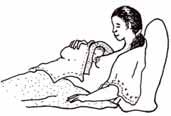4.1.2 Evidence that home visits improve the effectiveness of PNC
Unfortunately, there is not much evidence from research on home PNC visits in Ethiopia to serve as a model of best practice that can be replicated in every region of the country. However, there are experiences and evidence from South Asia that show significant results in improving PNC coverage and reducing the maternal and neonatal mortality rate within a short period of time, using a home-based approach. Of course, there will be cultural differences between countries, but the results are encouraging. For example, studies conducted in India, Bangladesh and Pakistan have shown that home visits can reduce deaths of newborns by 30-61% in developing countries where there is high mortality. In particular, home visits improved coverage of the key high-impact and cost-effective neonatal interventions such as:
- Early initiation of breastfeeding
- Skin-to-skin contact between newborns and their mothers (Figure 4.2).
- Delayed bathing of the newborn until at least 24 hours after the birth
- Attention to hygiene, such as hand washing with soap and water
- Hygienic care of the baby’s umbilical cord stump.

We will refer to each of these interventions later in this study session, or later in this Module. For now, you should simply note that although we do not have comparable Ethiopian research, these South Asian findings provide sufficient evidence of the key elements needed for effective home-based postnatal care in Ethiopia.
4.1.1 Barriers to facility-based postnatal care
